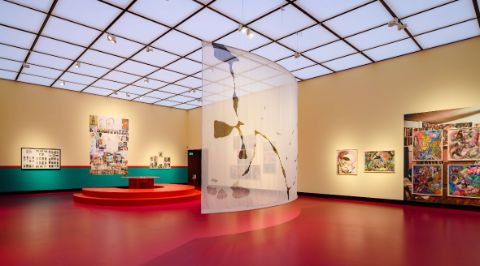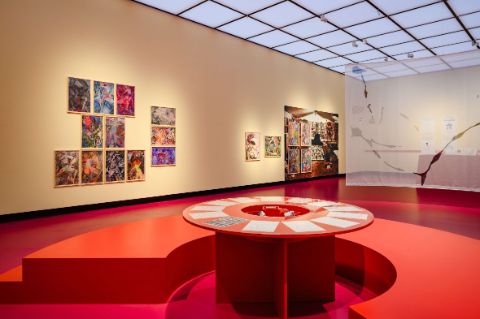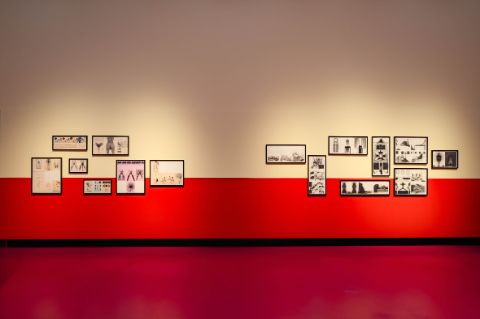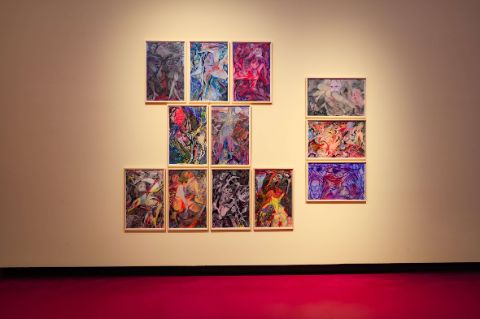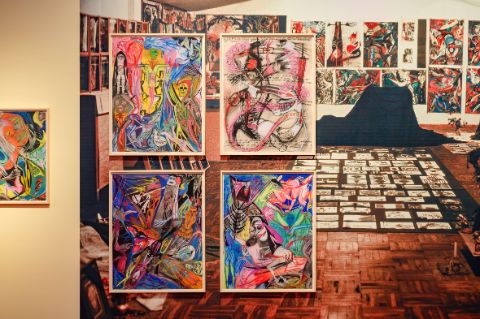Exercises in Transformation—Sergio Zevallos
Exhibition, Archive, Performances, Publication
21.10.2023–14.1.2024
The codes of power traverse bodies, linking the political with the personal. HKW’s exhibition Exercises in Transformation—Sergio Zevallos is dedicated to the more than four decades of Sergio Zevallos’s practice of embodying, investigating, and transmuting dominant knowledge systems, from whence other ways of thinking and imagining sprang up. For Zevallos, the labour of transforming imposed patriarchal and colonial knowledges begins in the body, in the most personal and intimate, and is worked through via performativity, social choreographies, and critical realism. The exhibition opens with a series of newly commissioned artworks by Zevallos based on the artists’s family archive of the magazine Sociedad y Política (Society and Politics), which was founded and edited by decolonial thinker Anibal Quijano in Peru (1972–1983) and co-edited by the artist’s father Abraham Zevallos[1]. Within a retrospective selection of Zevallos’s earlier work, the exhibition acknowledges the artist’s trajectory through the various artistic experiments carried out via gesture, voice, language, and bodily behaviour, including a social space to engage with the Archivo Ambulante (Wandering Archive), part of Zevallos’s underground performative work with the collective Grupo Chaclacayo in Lima and in Berlin (1982–1994).
[1] Among others, the editorial committee also included co-editors Julio Cotler, Cesar Germaná, and Heraclio Bonilla.
The exhibition focuses on the importance of practices that connect body and society, foregrounding Zevallos’s long-term commitment to engaging with political contexts, confronting the violence of sexist, misogynist, homophobic, racist, and bellicose societies. Together with Peruvian artist Raúl Avellaneda and German artist Helmut Psotta, Zevallos co-founded the Grupo Chaclacayo in Lima in 1982, beginning and organizing a collective in a studio in the outskirts of the city. Utilizing precarious ephemeral means as well as the urban popular aesthetic of images that circulate publicly, the collective experimented with drawings, performances, installations, and photographs, creating a range of transgressive works that questioned the violence of Peruvian politics during a period of tragic crimes caused by the internal armed conflict between the Maoist group Sendero Luminoso and the Peruvian State. Performing mostly outdoors—on streets, beaches, or in abandoned sites—Zevallos bound the intimacy of one's own body with the social environment. Composing allegorical scenes that transfigure religious, profane, and political references, the performers embodied different forms of metamorphoses such as the martyr, the androgynous, the tortured, the dancer at a macabre ball, or the lead in a funeral procession. By addressing radical questions about the body, its repression, and its liberation from the social convention of gender and the construction of masculinity, these works are praised as being foundational for queer aesthetics in Peru (‘estética marica’) in particular and Abya Yala in general.
By bringing Zevallos’s early works largely made in the 1980s into perspective, the exhibition Exercises in Transformation—Sergio Zevallos contributes to revindicating the body as a means to analyse society and transform oppressive ideologies. In the artist’s words, ‘la trayectoria (artística) como un aprendizaje de desobediencias’ (‘an artistic trajectory is an apprenticeship in disobediences’). Continuing to rework images and texts in public circulation, and by engaging the body and society, the intimate and the public, Zevallos has re-opened the family archive, delving into the thirteen issues of Sociedad y Política. The magazine featured articles that radically critiqued the structures of capitalism, colonialism, and imperialism, analysing the crisis of modern power as the combined crises of capitalism, patriarchy, ecology, and eurocentrism. By doing so, the magazine entered into Cold War debates, looking from the South to the East at the experiences of socialism in Cuba, Chile, Guinea Bissau, Central and Eastern Europe, or China. Editorial meetings were often held at the Zevallos’ house, with a young Sergio listening to the discussions of the editorial committee who had blocked off the living room—usually the kids’ play area.
In the exhibition, another form of performance is seen at play: over the years termites have joined the family archive, performing social and graphic choreography as they devour the magazines. Through this mode of intervening in and through texts, the termites’ aesthetic could be described as a form of visceral concrete poetry, generating patterns through their subtractive reading. It is the body, the social, the choreography, and the disobedience of the termites’ paths that Zevallos’s new work invites us to engage with.The exhibition speculates on the horizon of an alternative logic, continuing the persistent apprenticeship Zevallos proposed along four decades of exercises to transform the ‘coloniality of power’ (Aníbal Quijano). This way, the anti-colonial philosophy that first unfolded across the pages of Sociedad y Política continues to be performed.
Exercises in Transformation—Sergio Zevallos is part of a series of exhibitions dedicated to outstanding diasporic artists. The series is committed to create an exhibition format that foregrounds the languages and contexts shaping the artists’ work throughout their trajectories across communities and places. The series seeks to stimulate and support new artwork commissions within a curatorial retrospective reflection of the artist’s practice.
Sergio Zevallos (1962, Lima, lives in Berlin and Lima)
Sergio Zevallos works on issues of transcultural identity, gender and the relationship between the individual and power, or between intimacy and the codes of institutionality. Zevallos was co-founder of Grupo Chaclacayo, an art collective of the 1980s that dealt with the intersection of religion, gender, and armed conflicts in Lima, Peru, together with the German artist Helmut Psotta (1937, Bottrop–2012, Wesel), and the Peruvian artist Raúl Avellaneda (1960, Lima). In 1989 the group migrated to Germany and held the travelling exhibition Todesbilder through East and West Germany. In 1994, the group was dissolved. Zevallos has shown his work in institutions such as the Künstlerhaus Bethanien, Berlin; Württembergischen Kunstverein, Stuttgart; MAC, MALI and Centro Cultural de España, Lima; Reina Sofía, Madrid; MACBA, Barcelona; and Museo Universitario de Arte Contemporáneo MUAC, Mexico DF, among others. Zevallos has participated in the 31st Sao Paulo Biennial, 2014 and in documenta14, Kassel and Athens, in 2017. Sergio Zevallos has been awarded the Villa Romana Prize 2024.
Visitor information:
This exhibition is built on love, on a present and future of affirming joy, so we stand against the representation and repetition of violence through displaying images of hate and abuse under any circumstances.
We respectfully ask visitors to be aware that this exhibition might contain unintended depictions that could be distressing or violent. Viewer discretion is advised.
For inquiries and concerns: inquiries@hkw.de
